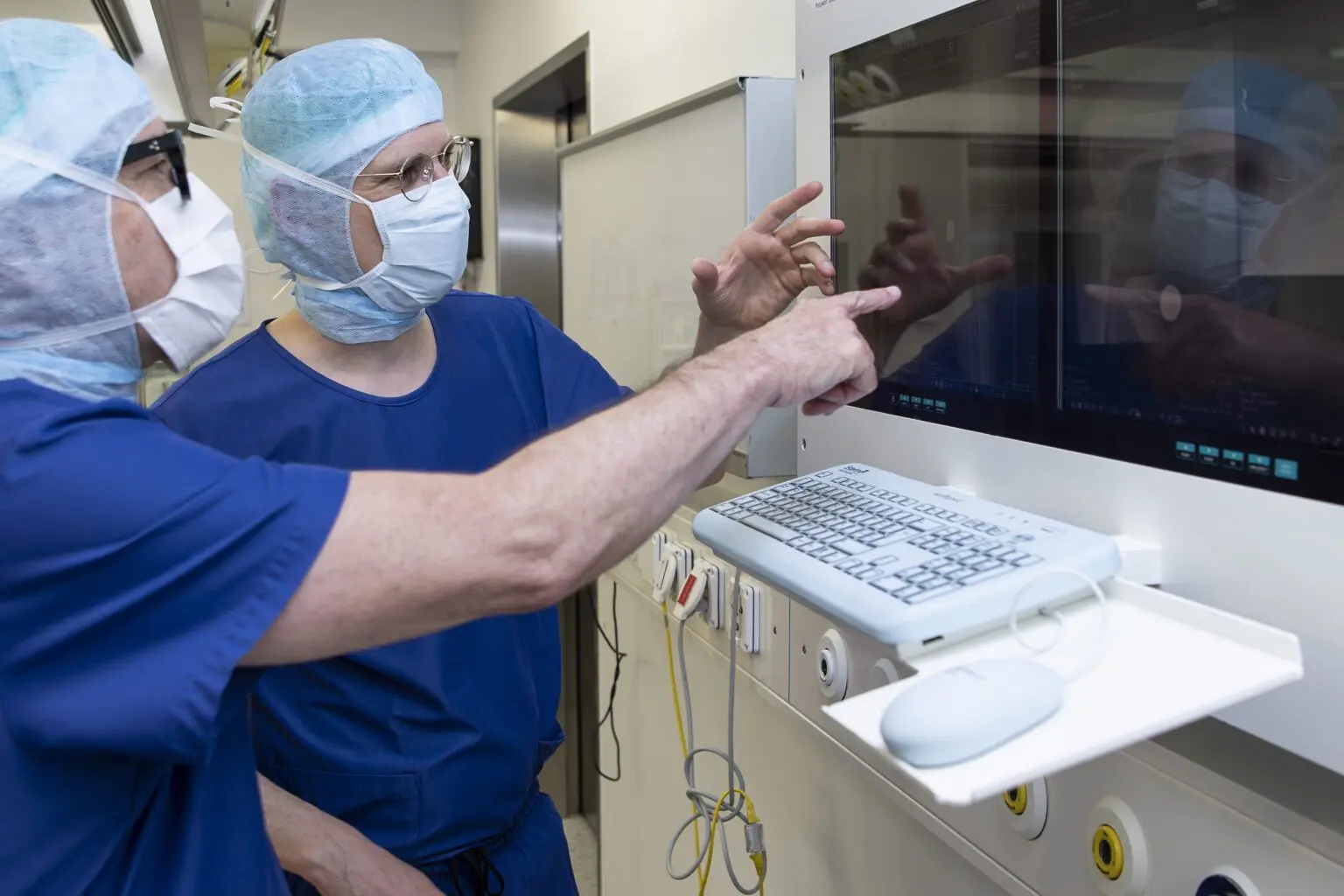
On the day of the operation, the main focus is on good pain management and minimizing blood loss. Numerous measures are combined to achieve this.
Hospital admission
As a rule, you will be admitted to hospital on the day of the operation. You will be informed of the exact time directly by the hospital the day before. This is usually around 2.5 hours before the planned time of the operation. On admission, you should report directly to reception, where you will be given further assistance. Some preparations will then be made at the admission clinic.
The operation
You will then be taken directly to the operating room or to anesthesia preparation. There you will be met by your anesthesia colleagues.
The operation itself takes about 1 hour. In the case of partial anesthesia (spinal anesthesia), you can sleep or listen to music during the operation. You don’t notice any of this.
The incision is made in the front above the knee joint. Old scars are reused where possible and integrated into the incision.
Since 2018, we have routinely used the robotic arm-assisted MAKO procedure to align the knee prosthesis. It provides precise information on the individual alignment of the prosthesis components and also on the stability of the ligament structures. According to the latest scientific findings, this reduces errors and minimizes the risk of re-operation. Rehabilitation is also usually somewhat faster due to the reduced surgical trauma.
At the end of the operation, the wound is sealed with a waterproof adhesive and a compression stocking is applied. You then go to the recovery room for about 2 hours and then back to the department.
Optimal patient care around the operation
A central aspect of optimized patient care is the reduction of blood loss and swelling after surgery in order to minimize complications and promote recovery. Various measures are combined to achieve this.
▪ Medication to minimize bleeding (tranexamic acid = Cyclokapron®).
▪ Lowering blood pressure during the operation
▪ Thigh compression stocking for 2-3 weeks
▪ Use of a special cooling and compression device (Game Ready) in the department
▪ Do not use drains
Thanks to the combination of these measures, the average blood loss of a knee prosthesis operation is around 300 ml so that blood transfusions are generally no longer necessary today. Compression therapy can reduce swelling after surgery by an average of 20-30%.
Optimized pain therapy
The focus is on minimizing pain in order to increase patient comfort and support the healing process. Various measures contribute to pain reduction in our Optimal Recovery Program.
▪ Particularly tissue-sparing surgical techniques
▪ Local infiltration anesthesia directly into the knee joint
▪ Nerve blocks on the thigh (adductor canal block)
▪ Standardized pain therapy according to a step-by-step scheme
▪ Reduction of swelling through cooling and compression
The first two days after a knee prosthesis operation are often quite painful. This is why you are still in hospital so that we can provide appropriate pain therapy. As soon as the pain is well tolerated, it is usually possible to go home.
Mobilization and physiotherapy
Mobilization begins immediately after the operation, as soon as you have full feeling in your legs again and your circulation is stable.
The prosthesis is usually fully weight-bearing straight away and you will learn to walk with walking sticks in hospital. You receive physiotherapy once a day and are given exercises for self-therapy, which are also compiled in a brochure. You are encouraged to extend your range of movement every day.
In the first few days, the focus is entirely on gaining independence and mobility. Before you leave the hospital, you will also practise climbing stairs. For the knee joint, full extension training and measures to reduce swelling are particularly important in the first 2-3 weeks.
Avoidance of complications
Knee prosthesis implantation is a very standardized procedure with a very low risk of complications overall. The main aim is to prevent thromboses, falls and infections.
To avoid thrombosis, it is important to mobilize your joint and yourself as early as possible. You can do exercises to prevent thrombosis yourself by moving your toes and feet up and down in bed. They also receive a daily injection to thin the blood (Fragmin). On discharge, the prophylaxis is changed to a tablet (Xarelto® or Aspirin cardio ®), which you should take for 14 days after the operation.
In addition to the standard surgical measures, we use a special wound dressing similar to a second skin to prevent infection. This seals your wound and must NOT be changed. It is simply left for 2 weeks. From the 2nd day after the operation you can also shower with it. Stitch removal is no longer necessary with this special dressing.
Leaving the hospital
The hospital stay is usually 2-4 days. The following criteria must be met for discharge from hospital to home:
▪ Irritation-free and dry wound
▪ Controlled pain
▪ Independent mobility with walking sticks
Hospital discharge is always by 9 a.m. (weekends by 10 a.m.).
In the week following discharge, you should continue with outpatient physiotherapy. Ideally, you should arrange your first appointments before you leave hospital. A wound check is scheduled 14 days after the operation. This can be done by your family doctor or by us in our consultation hours.
When you leave, you will receive the following documents from us:
▪ Prescription for outpatient physiotherapy
▪ Appointment for wound check-up after 14 days (if required)
▪ Appointment for check-up with X-ray after 2 months
▪ Prescription for medication (painkillers and thrombosis prophylaxis for 14 days)
▪ Certificate of incapacity for work (if required)
▪ Prosthesis pass